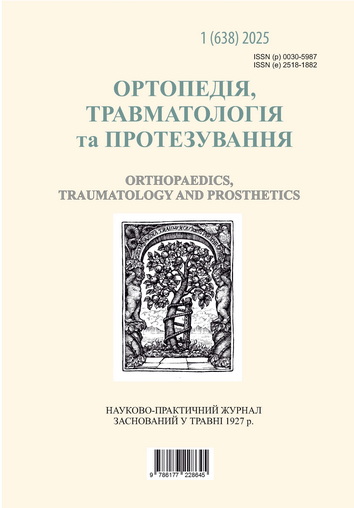UKRAINIAN-LANGUAGE VALIDATED SCALES FORGOTTEN JOINT SCORE-12 FOR PATIENTS AFTER HIP AND KNEE ARTHROPLASTY
DOI:
https://doi.org/10.15674/0030-59872025150-55Keywords:
Total hip arthroplasty, total knee arthroplasty, Forgotten Joint Score-12, FJS-12Abstract
The Forgotten Joint Score-12 (FJS-12) is an important tool for assessing the effectiveness of treatment of patients after large joint arthroplasty. Its main advantage is its sensitivity to the patient's subjective perception of the artificial joint, which makes it extremely useful for assessing the level of comfort after surgery. Objective. To perform an official translation of the Forgotten Joint Score-12 scale into Ukrainian, to conduct its adaptation and validation among patients who have undergone knee or hip arthroplasty. The translation was carried out within the framework of official cooperation with Forgotten Joint Scores (BGGK GmbH, Switzerland) in accordance with international standards Good Practice for the Translation and Cultural Adaptation Process for Patient-Reported Outcomes (PRO) Measures. Results. The pilot testing was conducted among 20 patients and was aimed at identifying the clarity of the questions, ease of completion and time required to complete the survey. That is why this scale allows to assess the degree of awareness of the presence of a joint implant in everyday life, is an important addition to existing methods of studying the results of treatment. Conclusions. Due to its unique approach, the FJS-12 allows for a more accurate assessment of the results of arthroplasty, which contributes to the improvement of surgical techniques, optimisation of rehabilitation programmes and improvement of the level of medical care. Its Ukrainian-language version is now available for use in clinical practice and scientific research in our country, which will contribute to a more objective assessment of the effectiveness of treatment of patients after total arthroplasty. This also opens up new opportunities for international cooperation, as it allows Ukrainian researchers to use unified assessment methods and compare their results with those of their colleagues.
Downloads
How to Cite
Issue
Section
License
Copyright (c) 2025 Stanislav Bondarenko, Volodymyr Filipenko, Valentyna Maltseva, Daryna Pryimak, Dmytro Sereda

This work is licensed under a Creative Commons Attribution 4.0 International License.
The authors retain the right of authorship of their manuscript and pass the journal the right of the first publication of this article, which automatically become available from the date of publication under the terms of Creative Commons Attribution License, which allows others to freely distribute the published manuscript with mandatory linking to authors of the original research and the first publication of this one in this journal.
Authors have the right to enter into a separate supplemental agreement on the additional non-exclusive distribution of manuscript in the form in which it was published by the journal (i.e. to put work in electronic storage of an institution or publish as a part of the book) while maintaining the reference to the first publication of the manuscript in this journal.
The editorial policy of the journal allows authors and encourages manuscript accommodation online (i.e. in storage of an institution or on the personal websites) as before submission of the manuscript to the editorial office, and during its editorial processing because it contributes to productive scientific discussion and positively affects the efficiency and dynamics of the published manuscript citation (see The Effect of Open Access).














